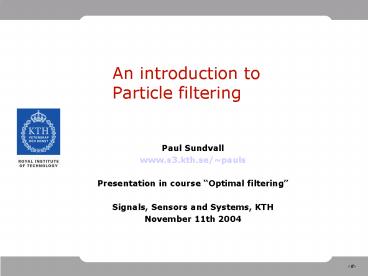An introduction to Particle filtering - PowerPoint PPT Presentation
1 / 13
Title:
An introduction to Particle filtering
Description:
The propability density function is approximated using point weights ... Calculation demand is proportional to the number of particles ... – PowerPoint PPT presentation
Number of Views:118
Avg rating:3.0/5.0
Title: An introduction to Particle filtering
1
An introduction to Particle filtering
- Paul Sundvall
- www.s3.kth.se/pauls
- Presentation in course Optimal filtering
- Signals, Sensors and Systems, KTH
- November 11th 2004
2
Outline
- Introduction
- Comparison with the Kalman filter
- Description of the algorithm
- Implementation
- Example
Paul Sundvall
3
Introduction
- Particle filtering
- is a method for state estimation
- is a Monte Carlo method
- handles nonlinear models with non-Gaussian noise
Paul Sundvall
4
Comparison to the discrete Kalman filter
Any distribution, uni- or multimodal
Gaussian, unimodal
Paul Sundvall
5
Significant property
- The particle filter gives an approximate solution
to an exact model, rather than the optimal
solution to an approximate model.
Paul Sundvall
6
Algorithm
- The propability density function is approximated
using point weights - Each point is called a particle
- Each particle has a positive weight
- Basic algorithm
- Initialize
- Time update (move particles)
- Measurement update (change weights)
- Resample (if needed)
- Goto 2 when new measurement arrives
- Each point is called a particle
- Each particle has a positive weight
- Initializew
7
Time Update
- One-step prediction of each particle
- Note that a realization of the
- process noise is used for every
- particle.
8
Measurement update
- The weights are adjusted using the measurement
- All weights are normalized
- Particles that can explain the measurement gain
weight - Particles far off the true state lose weight.
- The density of the cloud changes
9
Resampling
- It can be shown that the algorithm degenerates
- Allt particles but one become very light
- Solved by resampling so that all weights become
equal
10
Implementation
- Calculation demand is proportional to the number
of particles - The approximation error decreases as the number
of particles grow - N can easily be changed during runtime
- One needs to know what to do with p(x)
- is not a good choice for multimodal
distributions!
11
Example
- A boat travels on a one-dimensional sea
- Noisy depth measurements are given
- Given a perfect sea-chart d(x), estimate the
position!
- Matlab code for the example is available on
www.s3.kth.se/pauls
12
Final comments
- Better the more multimodal, non-linear and
non-gaussian the system is - The most basic variants are simple to implement
- It is easy to add model knowledge (saturation,
limit checking, nonnegativeness...)
- Variants of the particle filters exist
- To reduce the number of particles needed, by
combining Kalman filters and particle filters - To ensure that states with low propability but
high risk are tracked despite few particles
(fault detection) - To use discrete states
- To use both discrete and continuous states
(hybrid)
13
References
- A good introduction is given inA tutorial on
Particle Filters for Online Nonlinear/Non-Gaussian
Bayesian Tracking M. Sanjeev Arulampalam
et. al. - Very good application examples can be found in
Particle Filters for Positioning, Navigation
and Tracking Fredrik Gustafsson et. al. - A description of how particle filters can be used
for fault detection is found inParticle
Filters for Rover Fault Diagnosis Vandi
Verma et. al.































